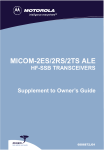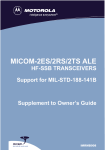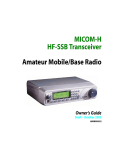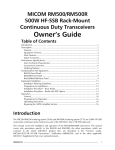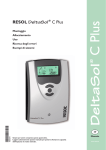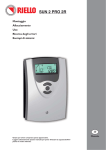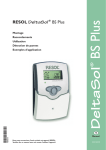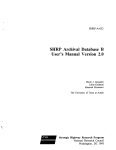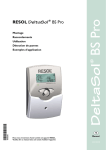Download Motorola MICOM-2ES Specifications
Transcript
COMMERCIAL WARRANTY (STANDARD) Motorola radio communications products are warranted to be free from defects in material and workmanship for a period of ONE (1) YEAR, (except for crystals and channel elements which are warranted for a period of ten (10) years) from the date of shipment. Parts, including crystals and channel elements, will be replaced free of charge for the full warranty period but the labor to replace detective parts will only be provided for One Hundred-Twenty (120) days from the date of shipment. Thereafter purchaser must pay for the labor involved in repairing the product or replacing the parts at the prevailing rates together with any transportation charges to or from the place where warranty service is provided. This express warranty is extended by Motorola Communications and Electronics Inc., 1301 E. Algonquin Road, Schaumburg, Illinois 60196, to the original purchaser only, and only to those purchasing for purpose of leasing or solely for commercial, industrial, or governmental use. THIS WARRANTY IS GIVEN IN LIEU OF ALL OTHER WARRANTIES EXPRESS OR IMPLIED WHICH ARE SPECIFICALLY EXCLUDED, INCLUDING WARRANTIES OF MERCHANTABILITY OR FITNESS FOR A PARTICULAR PURPOSE. IN NO EVENT SHALL MOTOROLA BE LIABLE FOR INCIDENTAL OR CONSEQUENTIAL DAMAGES TO THE FULL EXTENT SUCH MAY BE DISCLAIMED BY LAW. In the event of a defect, malfunction or failure to conform to specifications established by Seller, or if appropriate, to specifications accepted by Seller in writing, during the period shown. Motorola, at its option, will either repair or replace the product or refund the purchase price thereof, and such action on the part of Motorola shall be the full extent of Motorola's liability hereunder. This warranty is void if: a. The product is used in other than its normal and customary manner. b. The product has been subject to misuse, accident, neglect or damage. c. Unauthorized alterations or repairs have been made, or unapproved parts used in the equipment. This warranty extends only to individual products, batteries are excluded, but carry their own separate limited warranty. Because each radio system is unique, Motorola disclaims liability for range, coverage, or operation of the system as a whole under this warranty except by a separate written agreement signed by an officer of Motorola. Non-Motorola manufactured products are excluded from this warranty, but subject to the warranty provided by their manufacturers, a copy of which will be supplied to you on specific written request. In order to obtain performance of this warranty, purchaser must contact its Motorola salesperson or Motorola at the address first above shown, attention Quality Assurance Department. This warranty applies only within the United States. COMPUTER SOFTWARE COPYRIGHTS The Motorola products described in this instruction manual may include copyrighted Motorola computer programs stored in semiconductor memories or other media. Laws in the United States and other countries preserve for Motorola certain exclusive rights for copyrighted computer programs, including the exclusive right to copy or reproduce in any form the copyrighted computer program. Accordingly, any copyrighted Motorola computer programs contained in the Motorola products described in this instruction manual may not be copied or reproduced in any manner without the express written permission of Motorola. Furthermore, the purchase of Motorola products shall not be deemed to grant either directly or by implication, estoppel, or otherwise, any license under the copyrights, patents or patent applications of Motorola, except for the normal non-exclusive, royalty free license to use that arises by operation of law in the sale of a product. micomTrooper 2RS-BACKPACK 5-50 Watt HF-SSB TRANSCEIVER © MOBAT 3 Israeli Shimon St. P.O.B. 5090 Industrial Zone, Rishon le’Zion 75151, Israel All rights reserved Owner’s Manual Printed in Israel Cat. No. 6886863J01 micomTrooper 2RS-BACKPACK 5-50 Watt HF-SSB TRANSCEIVER Motorola 1720 West Paul Dirac Drive, Tallahassee 32310 FL, USA Owner’s Manual Cat. No. 6886863J01 WARNINGS, CAUTIONS AND NOTES The following notations are used to place special emphasis on procedures, or to call attention to precautionary measures. Warning An operating procedure, practice and so forth, which if not followed correctly, could result in personal injury, or loss of life. Caution An operating procedure, practice and so forth, which if not followed correctly, could result in damage to, or destruction of equipment. Note An operating procedure, condition and so forth, to which special attention should be paid. General Safety Precautions The following are general safety precautions that are not related to any specific procedures and therefore do not appear elsewhere in this publication. These are recommended precautions that personnel must understand and apply, in addition to the precautions listed in the Information for Safe, Efficient Operation section. Do not touch the antenna and the RF connectors when the transceiver operates. Warning High Voltage During transmission, high RF voltages appear at the RF connectors, the antenna cables, and on the antenna itself. These voltages may cause severe injury or even death on contact. Operating and maintenance personnel must be familiar with the applicable safety requirements before attempting to install or operate the transceiver. Severe injury or death could result from failure to comply with the safety practices. Information for Safe, Efficient Operation Product Safety and RF Exposure for Mobile TwoWay Radios Installed in Vehicles or as Fixed Site Control Stations Caution BEFORE USING THIS RADIO, READ THIS BOOKLET WHICH CONTAINS IMPORTANT OPERATING INSTRUCTIONS FOR SAFE USAGE AND RF ENERGY AWARENESS AND CONTROL INFORMATION FOR COMPLIANCE WITH RF ENERGY EXPOSURE LIMITS IN APPLICABLE NATIONAL AND INTERNATIONAL STANDARDS. The information provided in this document supersedes the general safety information contained in user guides published prior to February 2002. Compliance with RF Energy Exposure Standards NOTICE This radio is intended for use in occupational/controlled applications where users have been made aware of the potentional for exposure and can exercise control over their exposure. This radio device is NOT authorized for general population, consumer or similar use. Motorola, Inc. 2003 8000 W. Sunrise Blvd., Ft. Lauderdale, FL 33322 Printed in USA. 7/03 Federal Communication Commission Regulations The FCC has established limits for safe exposure to radio frequency (RF) emissions from mobile two-way radios. The FCC requires manufacturers to demonstrate compliance with RF exposure limits before mobile two-way radios can be marketed In the U.S. When two-way radios are approved for occupational/controlled environment exposure limits, the FCC requires users to be fully aware of, and exercise control over, their exposure. Awareness and control of RF exposure can be accomplished by education or training through appropriate means such as information and instructions in user manuals or safety booklets, or other appropriate means. This user safety booklet includes useful information about RF exposure and helpful instructions on how to control your RF exposure. Your Motorola two-way radio is designed and tested to comply with a number of national and international standards and guidelines (listed below) regarding human exposure to radio frequency electromagnetic energy. This radio complies with the IEEE (FCC) and ICNIRP exposure limits for occupational/controlled RF exposure environments at usage factors of up to 50% talk-50% listen. In terms of measuring RF energy for compliance with FCC exposure guidelines, your radio radiates measurable RF energy only while it is transmitting (during talking), not when it is receiving (listening) or in standby mode. Your Motorola two-way radio complies with the following RF energy exposure standards and guidelines: • United States Federal Communications Commission, Code of Federal Regulations; 47CFR part 2 sub-part J • American National Standards Institute (ANSI) / Institute of Electrical and Electronic Engineers (IEEE) C95.1-1992 • Institute of Electrical and Electronic Engineers (IEEE) C95.1-1999 Edition • International Commission on Non-Ionizing Radiation Protection (ICNIRP) 1998 • Ministry of Health (Canada) Safety Code 6: Limits of Human Exposure to Radiofrequency Electromagnetic Fields in the Frequency Range from 3 kHz to 300 GHz, 1999 • Australian Communications Authority Radiocommunications (Electromagnetic Radiation – Human Exposure) Standard, 2001 • ANATEL, Brasil Regulatory Authority, Resolution 256 (April 11, 2001: Additional Requirements for SMR, Cellular and PCS Product Certification. Compliance and Control Guidelines and Operating Instructions for Mobile Two-Way Radios Installed in Vehicles To control your exposure and ensure compliance with the occupational/ controlled environment exposure limits, always adhere to the following procedures: • To transmit (talk), push the Push-To-Talk (PTT) button; to receive, release the PTT button. Transmit only when people outside the vehicle are at least the minimum lateral distance away (as shown in table below) from a properly installed, externally-mounted antenna. The table below lists the minimum lateral distance for bystanders in an uncontrolled environment from the transmitting antenna at several different ranges of rated radio power for mobile radios installed in a vehicle. • Rated Power of Vehicle-Installed Mobile Two-Way Radio Minimum Lateral Distance from Transmitting Antenna Less than 7 watts 8 inches (20 centimeters) 7 to 15 watts 1 foot (30 centimeters) 16 to 50 watts 2 feet (60 centimeters) 51 to 110 watts 3 feet (90 centimeters) Install mobile antennas at the center of the roof or the center of the trunk deck per specific guidelines and instructions in the Radio Installation Manual. These mobile antenna installation guidelines are limited to metal body vehicles. Use only the Motorola-approved, supplied antenna or a Motorola- approved replacement antenna. Use of non-Motorola-approved antennas, modifications, or attachments could damage the radio and may violate FCC regulations. • For a list of Motorola-approved antennas, visit the following web site: http://www.motorola.com/cqiss/index.shtml. For additional information on exposure requirements or other training information, visit http://www.motorola.com/rfhealth. Compliance and Control Guidelines and Operating Instructions for Mobile Two-Way Radios Installed as Fixed Site Control Stations If mobile radio equipment is installed at a fixed location and operated as a control station or as a fixed unit, the antenna installation must comply with the following requirements in order to ensure optimal performance and compliance with the RF energy exposure limits in the standards and guidelines listed in the Federal Communication Commission Regulations section. • The antenna should be mounted outside the building on the roof or a tower if at all possible. • As with all fixed site antenna installations, it is the responsibility of the licensee to manage the site in accordance with applicable regulatory requirements and may require additional compliance actions such as site survey measurements, signage, and site access restrictions in order to ensure that exposure limits are not exceeded. Electromagnetic Interference/Compatibility Note Nearly every electronic device is susceptible to electromagnetic interference (EMI) if inadequately shielded, designed, or otherwise configured for electromagnetic compatibility. It may be necessary to conduct compatibility testing to determine if any electronic equipment used in or around vehicles or near fixed site antenna is sensitive to external RF energy or if any procedures need to be followed to eliminate or mitigate the potential for interaction between the radio transmitter and the equipment or device. Facilities To avoid electromagnetic interference and/or compatibility conflicts, turn off your radio In any facility where posted notices instruct you to do so. Hospitals or health care facilities may be using equipment that is sensitive to external RF energy. Vehicles To avoid possible interaction between the radio transmitter and any vehicle electronic control modules, for example, ABS, engine, or transmission controls, the radio should be installed only by an experienced installer and that the following precautions be used when installing the radio: 1. Refer to the manufacturer's instructions or other technical bulletins for recommendations on radio installation. 2. Before installing the radio, determine the location of the electronic control modules and their harnesses in the vehicle. 3. Route all radio wiring, including the antenna transmission line, as far away as possible from the electronic control units and associated wiring. Driver Safety Check the laws and regulations on the use of radios in the area where you drive. Always obey them. When using your radio while driving, please: • Give full attention to driving and to the road. • Pull off the road and park before making or answering a call if driving conditions so require. Operational Warnings For Vehicles with an Air Bag Warning Do not mount or place a mobile radio in the area over an air bag deployment area. Air bags inflate with great force. If a radio Is placed in the air bag deployment area and the air bag inflates, the radio may be propelled with great force and cause serious injury to occupants of the vehicle. Potentially Explosive Atmospheres Turn off your radio prior to entering any area with a potentially explosive atmosphere. Sparks in a potentially explosive atmosphere can cause an explosion or fire resulting in bodily injury or even death. The areas with potentially explosive atmospheres include fueling areas such as below decks on boats, fuel or chemical transfer or storage facilities, and areas where the air contains chemicals or particles such as grain, dust or metal powders. Areas with potentially explosive atmospheres are often, but not always, posted. Blasting Caps and Blasting Areas Warning To avoid possible interference with blasting operations, turn off warning your radio when you are near electrical blasting caps, in a blasting area, or in areas posted: "Turn off two-way radio". Obey all signs and instructions. For radios installed in vehicles fueled by liquefied petroleum gas, refer to the (U.S.) National Fire Protection Association standard, NFPA 58, for storage, handling, and/or container information. For a copy of the LP-gas standard, NFPA 58, contact the National Fire Protection Association, One Battery Park, Quincy, MA. Table of Contents Page Chapter 1 Introduction.......................................................................... 1-1 1-1. Scope ......................................................................................... 1-1 1-2. Purpose and Use......................................................................... 1-2 1-3. Equipment Description................................................................ 1-4 1-3.1 Functional Description ................................................... 1-4 1-3.2 Main Operational Features ............................................. 1-4 1-4. Main Technical Specifications...................................................... 1-7 Chapter 2 Preparation for Operation .................................................... 2-1 2-1. Scope ......................................................................................... 2-1 2-2. Unpacking and Inspection........................................................... 2-2 2-3. Familiarization with Main Equipment Components ......................... 2-3 2-3.1 Backpack Carrying Harness ............................................ 2-3 2-3.2 micomTrooper Transceiver ............................................. 2-5 2-4. Preparing for Backpack Operation............................................... 2-6 2-4.1 Outline of Preparation Procedures.................................. 2-6 2-4.2 Installation of micomTrooper Battery .............................. 2-6 2-4.3 Installation of Transceiver in Carrying Harness................. 2-8 2-4.4 Installation of Whip Antenna .......................................... 2-12 2-4.5 Connection of Audio Accessories.................................... 2-14 2-4.6 Wearing the Backpack Carrying Harness......................... 2-14 Chapter 3 Operation ............................................................................. 3-1 3-1. Scope ......................................................................................... 3-1 3-2. Channel Mode Menu .................................................................. 3-2 3-3. Menu Functions .......................................................................... 3-3 Cat. No. 6886863J01 i Table of Contents (Cont'd) Page Appendix A Static Operation.................................................................... A-1 A-1. Scope ......................................................................................... A-1 A-2. Procedure ................................................................................... A-1 Appendix B Using Battery Charger, FLN9541 .......................................... B-1 B-1. Purpose and Use......................................................................... B-1 B-2. Operating Instructions ................................................................. B-2 B-3. Main Technical Specifications...................................................... B-3 ii LIST OF ILLUSTRATIONS Page Figure 1-1. micomTrooper Ready for Operation, General View ................... 1-3 Figure 2-1. Typical Backpack Carrying Harness, General View..................... 2-3 Figure 2-2. Typical Backpack Carrying Harness, Open View ........................ 2-4 Figure 2-3. micomTrooper Transceiver, General View ................................. 2-5 Figure 3-1. Channel Mode Menu................................................................ 3-2 Figure 3-2. Menu Functions (Page 1 of 3))................................................... 3-3 Figure 3-3. Menu Functions (Page 2 of 3).................................................... 3-4 Figure 3-4. Menu Functions (Page 3 of 3).................................................... 3-5 Figure A-1. Connecting the Dipole or Long-Wire Antenna ...........................A-3 iii Intentionally Left Blank iv Chapter 1 Introduction 1-1. Scope This manual provides operating instructions for the micomTrooper, a highfrequency (HF) single sideband (SSB) backpack transceiver. The manual is organized as follows: Chapter 1 – General Description: provides a general description of the micomTrooper backpack transceiver and presents its main technical characteristics. Chapter 2 – Preparation for Operation: provides instructions for preparing a micomTrooper transceiver for backpack operation. Chapter 3 – Operating Instructions: presents concise operating instructions for the micomTrooper transceiver. Appendix A – Static Operation: provides instructions for preparing the micomTrooper for static operation using a dipole or long-wire antenna. Appendix B – Using Battery Charger FLN9541: provides instructions for using the FLN9541 for recharging the Lithium ion battery used by micomTrooper transceivers. micomTrooper is part of the MICOM family of HF-SSB radio sets; it has compatible characteristics and uses the same operating procedures as other MICOM transceivers. Therefore, this manual is intended for use with the following manuals: • "MICOM-2E/2R ALE HF-SSB Transceiver Owner’s Guide", Publication 68P02952C60-A, which presents the common operating procedures • "MICOM-2ES/2RS/2TS ALE HF-SSB Transceiver” Supplement 68MB000010 to the Owner’s Guide 68P02952C60-A, which presents additional capabilities and operating procedures. Cat. No. 6886863J01 1-1 1-2. Purpose and Use micomTrooper (MICOM-2RS) transceiver is a backpack version of the robust MICOM-2R mobile radio. For backpack operation, micomTrooper is powered by a lightweight Lithium ion rechargeable battery, has selectable power output of 5 to 20 W and high sensitivity, and uses a foldable whip antenna matched by a built-in automatic antenna tuner unit. When necessary, micomTrooper can be programmed to reach a power output of 50 W, and can also be used with dipole, long-wire and many other types of broadband antennas for static operation. These capabilities provide reliable long-range HF-SSB radio communications in a rugged yet lightweight backpack configuration. Designed to meet the needs of users who carry out on-foot operations in remote areas, it is built to withstand years of shock and vibration as well as severe weather conditions. micomTrooper is certified for dependability and durability, and complies with US standard MILSTD-810F. The micomTrooper is equipped with a military-type handset, whip antenna, cables and connectors, delivering superior quality in a radio priced to fit the needs of a wide range of organizations. For backpack operations, the micomTrooper is carried in a convenient, lightweight harness that completely envelops the transceiver. The durable aluminum frame of the harness protects against damage and allows placing the transceiver on ground for static operations. Figure 1-1 shows a general view of a micomTrooper ready for backpack operation, as seen when the harness protection flap is opened. 1-2 Whip Antenna micomTrooper Transceiver Antenna Base Backpack Carrying Harness Handset Figure 1-1. micomTrooper Ready for Operation, General View 1-3 1-3. Equipment Description 1-3.1 Functional Description The micomTrooper is an advanced and flexible backpack-portable HF-SSB transceiver that provides a complete solution to the communication requirements in the crowded HF band. micomTrooper has an automatic antenna tuner, which supports a wide range of antennas, including a light-weight foldable whip for portable (backpack) operation; dipole, long wire, and many other types of antennas can be used for static operation. The micomTrooper provides voice, data, and telegraphy (CW) communication. Communication reliability and quality is improved by means of automatic frequency management and automatic link establishment (ALE). In addition, the ALE function also provides Automatic Message Display (AMD), that enables operators to exchange preprogrammed messages while establishing a link. The transmit output power is operator-selectable (5, 10 or 20 W). When used in a backpack configuration, the operator can reduce the transmit power and thus increase battery life when the communication conditions do not require the maximum transmit power (20 W). Under bad propagation conditions or in an emergency, the operator can rapidly switch to static operation by simply placing the self-supporting micomTrooper harness on ground, and increase the transmit power to 50 W. Under static operating conditions, the operator can easily connecting a dipole or another long wire antenna instead of the whip, further increasing communication efficiency. Using a dipole or long wire antenna also extends the lower operating frequency from 3.0 to 1.6 MHz. micomTrooper is powered by a 16V, 12Ah rechargeable Lithium ion battery, type ML1416-L. Spare batteries can be carried in the backpack harness. 1-3.2 Main Operational Features This section presents a concise list of the main operational features of the micomTrooper transceiver. For a description of the additional capabilities and features of MICOM transceivers, see the "MICOM-2E/2R ALE HF-SSB Transceiver Owner’s Guide", Publication 68P02952C60-A, and the "MICOM-2ES/2RS/2TS ALE HF-SSB Transceiver” Supplement 68MB000010 to the Owner’s Guide 68P02952C60-A. 1-4 ➤ Fast and simple radio link establishing: Automatic Link Establishment (ALE) per MIL-STD-1045 and MIL-STD-188-141. Full interoperability with other manufacturers' radios complying with the same ALE standards. ➤ Loud and clear voice communication: Built-in voice quality system with proprietary DSP algorithms that filter out background noises and elevates sound bytes, providing exceptional communication clarity. Selectable bandwidth, for fine tuning and optimal voice reception. Unmatched combination of high power (up to 50 W) and high sensitivity (0.5 µV) for outstanding communication coverage. Voice-activated digital squelch. ➤ User-friendly operation: Large alphanumeric front panel display and keyboard for programming and set-up. Support for multiple languages. ➤ Years of trouble-free, advanced communications. Upgrading to future technologies is easily made by installing new software into the transceiver's DSP unit. Easily replaceable digital maintenance and repair. components ensure cost-effective Very high MTBF, as with all MICOM radios. Unique Built-In Self Test system that provides exceptional diagnostic capability. ➤ Comprehensive communication and networking services MultiNet enables integration of different HF radio networks into one seamless network, allowing excellent coordination between different units and forces. AMD for transmission and reception of pre-set text messages. Optional GPS embedded application. 1-5 ➤ Part of a proven family of radio products: micomTrooper is a member of the family of MICOM radio transceivers for fixed base stations, mobile vehicle-mounted and hand-carried units serving the long-range wireless communication needs of hundreds of organizations worldwide. ➤ Main optional accessories: Secure voice AC battery charger, FLN9541 External GPS Spare 12Ah rechargeable Lithium ion battery. 1-6 1-4. Main Technical Specifications Specifications Frequency Range With Whip Antenna 3.0 to 30 MHz With Dipole or Long Wire 1.6 to 30 MHz Dimensions Options Number of Preset Channels 200 Transmit Power 5, 10, 20, 50 W Receive Frequency Range 100 kHz – 30 MHz Rx Sensitivity SSB: 0.5 µV for 10 dB SINAD Audio Bandwidth 350 to 2700 Hz Frequency Stability 0.6 ppm Frequency Resolution 10 Hz Operating Temperature Range -124 to +184°F (-30 to +60°C) Operating Voltage 12V nominal Height 17.7 inch (450 mm) Width 13 inch (330 mm) Depth 5.1 inch (130 mm) Weight 16 lbs (7.1 kg) RS-232 Remote Control Interface RSS for PC (Radio and ALE) Multinet Operation (for ALE) 1-7 Intentionally Left Blank 1-8 Chapter 2 Preparation for Operation 2-1. Scope This Chapter provides instructions for preparing the micomTrooper for backpack operation. The information presented in this Chapter includes: • Unpacking – para. 2-2 • Familiarization with main equipment components − para. 2-3 • Preparation for backpack operation – para. 2-4. Refer to Appendix A for instructions on how to adapt the backpack transceiver to static operation with dipole or other long-wire antennas. During transmission, dangerously high RF voltages appear at the RF connectors, the antenna cables, and on the antenna itself. Warning Do not touch the antenna and the RF connectors when High Voltage the transceiver operates. Make sure the antenna is not near high-voltage lines. Warning Lithium batteries contain dangerous chemicals. Handle and dispose of used Lithium batteries according to the prescribed safety regulations. In particular, observe the following precautions: 1. Do not short-circuit Lithium batteries. 2. Do not damage battery case and do not tamper with battery in any way. 3. Do not dispose of used Lithium batteries by burning or incinerating. Cat. No. 6886863J01 2-1 2-2. Unpacking and Inspection a. A preliminary inspection of the equipment containers should be made prior to unpacking. Evidence of damage should be noted and reported immediately to the proper authorities. Unpack the equipment as follows: (1) Place each container on a clean flat surface, cut all straps, and open or remove the top. (2) Take out each item carefully and place it securely on a clean surface. (3) Remove the packing material while looking for small items. (4) Fold and store the containers and packing materials for use. b. Checking Unpacked Equipment. 2-2 (1) Inspect all items for damage. found. Immediately report any damage (2) Check all items against the items listed in the accompanying packing slip. Report any missing items or discrepancies. 2-3. Familiarization with Main Equipment Components Before continuing, review Figure 1-1, which shows a micomTrooper transceiver installed in the harness. 2-3.1 Backpack Carrying Harness Figure 2-1 shows a general view of a typical backpack carrying harness. The harness has a frame that supports the transceiver. When placed on level ground, the four feet of the frame support the whole assembly in a vertical position. Shoulder Straps Protection Flap (Closed) Harness Frame Storage Pouches Breast Strap Shoulder Strap Adjustment Buckle Bottom Flap (Closed) Waist Straps Figure 2-1. Typical Backpack Carrying Harness, General View 2-3 The frame, together with the whole transceiver, is completely enveloped by the harness cloth and its upper and bottom flaps, and therefore only the antenna and the handset protrude. Two storage pouches for storing accessories and/or spare batteries are located to the two sides. All the flaps and covers are held by Velcro fasteners. Figure 2-2 shows a view of the open harness, as needed to gain access for installing the equipment in it. Note the location of the battery pouch, and the transceiver retaining straps. Protection Flap (Open) Harness Frame Retaining Straps Bottom Flap (Open) Battery Pouch Figure 2-2. Typical Backpack Carrying Harness, Open View 2-4 2-3.2 micomTrooper Transceiver Figure 2-3 shows a general view of the micomTrooper transceiver, and its connectors. Note the coaxial cable connecting the transceiver to the automatic antenna tuner (ATU). micomTrooper Transceiver Automatic Antenna Tuner (ATU) Whip Mount ATU RF Connector Transceiver RF Connector Coaxial Cable Power Connector Figure 2-3. micomTrooper Transceiver, General View 2-5 2-4. Preparing for Backpack Operation 2-4.1 Outline of Preparation Procedures The preparation of a micomTrooper transceiver for operation includes: 1. Installation of battery in carrying harness. 2. Installation of transceiver in carrying harness. 3. Installation of antenna and audio accessories. 4. When ready to go − wearing the backpack carrying harness. 2-4.2 Installation of micomTrooper Battery 1. Place the carrying harness on a clean, flat surface. 2. Release the two battery flaps, and then release the two straps holding the battery (all these items have Velcro fasteners). 3. Remove old battery, if any. 4. Visually check battery and battery pouch for dirt or damage. Clean if necessary. 5. Orient the battery as shown in figure, and push the battery in place. 6. Reattach the two straps holding the battery, and then close the battery pouch with its flaps (first the bottom flap, and then attach the upper flap). 2-6 Upper Battery Flap Battery Straps Lower Battery Flap 2-7 2-4.3 Installation of Transceiver in Carrying Harness 1. Place the carrying harness on a level surface, with the metal braces facing upward. 2-8 2. Place the micomTrooper on the top of the carrying harness, with its front panel upwards and its rear resting on the carrying harness (see figure). Note position of audio connectors: they must be to the left. 3. Connect the three-pin D-type power connector of the power cable to the micomTrooper power connector. Fasten securely the two connector screws. 4. Connect the other connector of the power cable to the battery connector. Fasten securely the connector screw. Transceiver Power Connector Power Cable Battery Connector 2-9 5. Push the transceiver down, toward the battery, until it is stopped by the aluminum frame. 6. Fasten the transceiver to the carrying harness with the two retaining straps. 7. Close the harness around the transceiver as shown in the figure on the next page (the Velcro fasteners will keep it in position). 2-10 2-11 2-4.4 Installation of Whip Antenna 1. Visually inspect the whip mount connector (located on the ATU) for dirt or damage. Clean if necessary. 2. Screw antenna base AB-591 into the whip mount connector. Tighten by hand only. 3. Extend the whip: this is done by carefully whipping it outwards. Secure all sections by inserting them one into the other by hand. 4. Screw whip antenna sections into antenna base. 5. To remove the whip antenna, perform the above tasks in the reverse order. CAUTION When folding the whip, always start with the upper section, otherwise it may be damaged. 2-12 Whip Antenna Antenna Base Whip Mount Handset 2-13 2-4.5 Connection of Audio Accessories 1. Connect the handset, H-250, to either of the two audio connectors on the front panel of the micomTrooper. 2. If necessary, connect an additional audio accessory, for example, telegraphy key or headset, to the other audio connector. 2-4.6 Wearing the Backpack Carrying Harness To wear the backpack: • Put harness on your back by inserting arms through shoulder straps. • Tighten shoulder straps. • Buckle waist straps to belt and adjust to size. • Adjust the breast strap length and then attach the strap. At this stage, the micomTrooper is ready for use as a backpack radio set. 2-14 Shoulder Straps Protection Flap (Closed) Breast Strap Shoulder Strap Adjustment Buckle Bottom Flap (Closed) Waist Strap 2-15 Intentionally Left Blank 2-16 Chapter 3 Operation 3-1. Scope This Chapter presents concise operating instructions for the micomTrooper transceiver. The information appearing in this Chapter assumes that you are familiar with the operation of the MICOM family of HF-SSB transceivers, and in particular with the operating instructions presented in the following manuals: • "MICOM-2E/2R ALE HF-SSB Transceiver Owner’s Guide", Publication 68P02952C60-A, which presents common operating procedures for MICOM transceivers • "MICOM-2ES/2RS/2TS ALE HF-SSB Transceiver” Supplement 68MB000010 to the Owner’s Guide 68P02952C60-A, which presents additional capabilities and operating procedures. Therefore, the Chapter presents only the menu structure of the micomTrooper transceiver. Cat. No. 6886863J01 3-1 3-2. Channel Mode Menu Figure 3-1 shows the micomTrooper channel mode menu. CH F 2,000.000 BAND SQ DSP™ MORE SQ BAND DSP ON OFF LSB USB CLAR NF CLIP NB ATTN ON OFF ON OFF ON OFF MORE MORE PWR MODE LOW MED HIGH MAX MORE SSB AME PLT AGC OFF SLOW FAST MORE RCLV CALL .. . .. ALL CALL NET 1 .. .. . NET 20 MON ON OFF Figure 3-1. Channel Mode Menu 3-2 BW 2.1 2.7 3.0 3.3 LSM CW 3-3. Menu Functions Figure 3-2, Figure 3-3 and Figure 3-4 show the menu functions, reached after pressing the MENU button. MENU CHAN FREQ ALE BIT™ MORE CHAN FREQ 1 2 3 4 ALE SMPX DPLX RXO TXO NET BIT FULL CHAN RF ENTER NO MORE LOCK PROG PSW LOCK PSW PSW OLD RAD See Figure 3-3 ALE See Figure 3-4 LANG DIM LEVEL 0123 FRNC SPAN BAH Figure 3-2. Menu Functions (Page 1 of 3)) Note When using the micomTrooper with its whip antenna, make sure to select YES for the TUNER option (MENU>MORE>PROG>RAD>OPTS – see Figure 3-3). When using the micomTrooper with a dipole or long wire antenna (static operation as described in Appendix A), make sure to select NO for the TUNER option. 3-3 MENU LOCK PROG PSW DIM™ RAD ALE LANG See Figure 3-4 See Figure 3-2 OPTS PRMT CHAN TUNE ACC YES NO MORE BAUD DPWR MST AST STOR ERAS PTBP PWR AMP ACC1 ACC2 NON KBBP TONE FREQ ADT ATTN MORE BAND MODE AGC BW Figure 3-3. Menu Functions (Page 2 of 3) 3-4 YES NO MORE MORE GET ALE CW RCLV DIM MENU LOCK PROG PSW DIM™ RAD LANG ALE See Figure 3-3 See Figure 3-2 MORE DIR NET OPT AMD AUTO STOR ADDR AMD ADD ERAS EDIT YES NO ERAS YES NO MORE MORE PTOT .. .. . EXAL ALRT YES NO YES NO 1 .. .. . 10 TOT MLQA YES NO .. .. . 0 .. .. . 100 QCAL AADR YES NO YES NO MxCH .. .. . 0 .. .. . 59 MORE NAME MEMB CHAN OPT GET ERAS YES NO MORE MORE NET SELF HACK SOND ADD ERAS SLNT SORT MACK OCUP LQAR ADD ERAS ALLC SCN ALLC M/S TUNE Figure 3-4. Menu Functions (Page 3 of 3) 3-5 Intentionally Left Blank 3-6 Appendix A Static Operation A-1. Scope This Appendix provides instructions for preparing the micomTrooper for static operation using a dipole or long-wire antenna. A-2. Procedure When using a micomTrooper transceiver with a dipole or long-wire antenna, the antenna must be directly connected to the transceiver RF connector. Therefore, it is necessary to disconnect the connection between the transceiver and ATU. In the following procedure, refer to Figure A-1. Cat. No. 6886863J01 A-1 ➤ To connect a dipole or long-wire antenna: 1. Turn the transceiver off. 2. Open the harness envelope, to reach the coaxial cable interconnecting the RF connectors of the transceiver and the ATU. 3. Disconnect the cable from the transceiver RF connector. 4. Connect the coaxial feed of the antenna directly to the transceiver RF connector. 5. You may now disassemble the whip antenna (see Chapter 2). 6. Close the harness envelope. You may now operate the transceiver with the dipole or long-wire antenna. ➤ A-2 To return the transceiver to regular operation (with whip antenna): Reconnect the ATU to the transceiver and reinstall the whip antenna by reversing the procedure given above. 2. Connect Coaxial Feed Connector 1. Disconnect Cable from ATU Coaxial Feed to Dipole or Long Wire Antenna Figure A-1. Connecting the Dipole or Long-Wire Antenna A-3 Intentionally Left Blank A-4 Appendix B Using Battery Charger, FLN9541 B-1. Purpose and Use FLN9541 is an AC-powered battery charger designed to charge 16V, 12Ah Lithium ion rechargeable batteries of the type used by micomTrooper (ML1416-L). FLN9541 is simple to operate and does not require operator attendance during operation. Yet it provides advanced features, such as fully automatic charging and automatic turn-off after battery charging is completed. Three indicators display the operating state, and sounds are used to signal proper connection of battery, end of charge, etc. FLN9541 has only two controls: • POWER on/off switch. When the FLN9541 is turned on, a green indicator, UDC, lights to indicate that the charger is OK. • CHARGE pushbutton (red): after connecting the battery to be charged, press the pushbutton to start charging. While charging, a yellow CHARGE indicator lights. The end of charge is indicated by the flashing of a green FINISH CHARGE indicator. The battery charger is a compact unit, intended for use in rooms, shelters, etc. Do not expose the battery charger to direct sun radiation or excessive temperatures, rain, snow, or high humidity. Keep charger battery contacts clean and avoid accidental short-circuits by turning the charger on only after a battery is installed on the charger. Cat. No. 6886863J01 B-1 B-2. Operating Instructions 1. Place the battery charger on a flat surface, protected from sun and rain. 2. Insert the charger power cable plug into an AC outlet. 3. Connect the battery to be charged to the battery charger: place the battery socket over the charger pins and press firmly to mate (the connectors will mate only if battery is placed with the correct orientation). Beeps must be heard, to indicate proper contact with the charger. Note Beeps must be heard, to indicate proper contact with the charger. If no beeps are heard, remove and then reconnect the battery. Also check that the charger pins are clean. If no beeps are heard after the battery is reconnected, the battery is probably bad and cannot be recharged. 4. 5. Turn the charger on by setting its front panel POWER switch to ON: • The green UDC indicator will light • The green FINISH CHARGE starts flashing, and a tone is heard. Start the charging by pressing the red CHARGE pushbutton. The yellow CHARGE indicator will turn on and the tone stops. Note 6. The charger now operates automatically. Note B-2 If the battery is faulty or makes bad contact with the battery charger, the CHARGE indicator will not turn on after pressing the CHARGE pushbutton, and no charge current is supplied to the battery. If a power source failure occurs while the battery is being charged, the FINISH CHARGE starts flashing, and an alarm tone is heard. To resume charging after power returns, press again the red CHARGE pushbutton. 7. You will be notified when the battery is fully charged: the FINISH CHARGE indicator will start flashing and the tone is heard again. 8. At this stage, set the POWER switch to OFF, and remove the battery from the charger. 9. Disconnect the charger power cable from the AC outlet. B-3. Main Technical Specifications Input voltage 90 to 265 VAC, 20 to 60 Hz Charged battery voltage 16.8 ±0.2 V Charging current 3.6 A Dimensions 220 × 165 × 50 mm Weight 1.25 kg Environmental service conditions Temperature Humidity B-3 Intentionally Left Blank B-4
























































